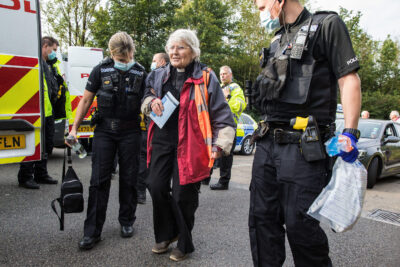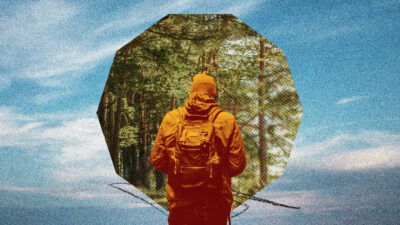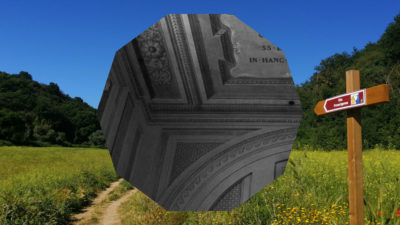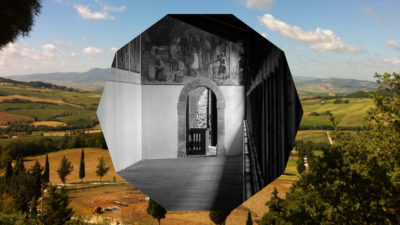On the morning of Tuesday 11th April 2023, Community of the Passion member Lya Vollering set off from Canterbury to begin walking the 1,800km pilgrimage trail known as the Via Francigena, which has Rome as its destination.
Walking an ancient path to the future, Lya does so as an act of ecological witness in the midst of our climate crisis, to call attention to the urgent need to heal and care for the earth, our common home.
Here we share her thirteenth week of reflections on the journey.
Tuesday 4th July: Towers & River
For the second time on this journey, the sight of a church moved me to tears. It was a Romanesque building belonging to a religious community of men and woman.
The only decoration was a Taize-style cross hanging from the ceiling and three icons, two of which were facing each other on the side walls. One depicted the Madonna and child and the other was of Jesus washing the feet of a disciple. At the back of the church, next to the baptismal font, was an icon of Jesus’s baptism by John. The church was dimly lit. I put my rucksack down and sat on the back bench and wept inexplicably. Was I overcome by the beauty of the place or its atmosphere? Maybe it’s both, but it is also the fact that I feel more emotional than usual because I am nearing the end of this long journey.
From the monastery, it was only a couple of kilometres to San Gimignano, a UNESCO world heritage site. Citing my guidebook: ‘the city centre is a jewel of medieval architecture. Most notable of its buildings are the fifteen remaining towers (once there were seventy two) erected by patrician families to safeguard their valuables and display their affluence”. The story of Babel and the parable of the farmer storing his surplus crops in extra barns comes to mind. The town flourished until 1348 when the Black Plague killed half of the population and led to a decline in its political and economic importance. This prevented it from redevelopment in later centuries. Now it is a very popular place for tourists, though it is much smaller than Lucca. I visited the Duomo Collegiate Church, which is full of frescoes from the 14th century. It was beautiful. I enjoyed sitting in the shade outside the church and listening to two men playing stringed instruments. One was a harp but I didn’t recognise the other. I sat with a young Dutch couple and soaked in the peace of the place and watched people passing by.
Today (Tuesday 4th July) brought a beautiful walk through the Tuscanian landscape, with its old villages, vineyards in full leaf and the grapes now forming, its mature olive trees, plentiful cypresses and woodland. What makes this landscape so attractive are these features, alongside the agriculture. The best part of the day was walking along the river in a wooded area. A couple of times I had to cross it by stepping on large rocks positioned amid the strong current. Luckily, there was a rope to hold onto. It added to the fun. I also enjoyed swimming in this river. I had stopped at a picnic table and had paddled my feet in the water but soon desired a swim. While I was deciding whether to take the plunge, Viviane, the Italian pilgrim, reached the same spot and, without hesitation, she went straight into the water in her shorts and bra. I had to follow! I didn’t regret it as it was so refreshing!
Today, I am staying at an old hostel which has offered hospitality to pilgrims since 1050 CE. I am in the company of Lynn and Viviane and an Italian mother with her three teenage sons. For pilgrims who have walked more than thirty stages it works on a donation basis. For the ones who have travelled less, it involves a fixed price. This is the first time I have come across this rule. I am looking forward to supper, when we will eat all together.
Thursday 6th July: Companions on the Road
The moon was still clearly visible, even though it was not full anymore. The sun was coming up and the sunflowers stood erect in all their glory in the early morning mist. On a hilltop in the distance, I could see the old towers of Monteriggioni. I sang out my thanksgiving.
The route led through woodland and fields. After 14km, I was hoping to find a cafe for my morning coffee. I noticed on my app that there was one nearby but, having passed it already, I turned and went back. It wasn’t the usual bar/cafe. This was an outdoor one set up for pilgrims. Marcelino (his name was printed on the back of his T-shirt) runs the place. He offered breakfast and cakes and coffee, of course. He was very keen to have a photo with me for his Facebook page. Two young American women arrived. They were doing a few days of the Via Francigena, as a pleasant way of seeing Tuscany. Yesterday, I met a mother and daughter from Sweden who were doing the same thing.
I arrived in Siena today. Another place full of history, with medieval buildings. It has a stunning square with an enormous palace. There is also a must see duomo, known for its black and white marble and beautiful mosaic floor. However, I didn’t go to see it. I feel overwhelmed with all the churches full of decorations, frescos, marble, mosaics and statues. Instead, I went to look for the place where I was going to stay. It is called Santa Luisa. I hadn’t realised it was a convent. An elderly religious sister in a habit welcomed us. Lynn, Viviane and I had booked together. She immediately offered us cold water. She was hoping to get someone else to show us the room but, not getting a response, she climbed the four flights of stairs with difficulty. We were shown to a pleasant but simple room bearing a name plate on the door which said, ‘Sister Agatha’. The elderly nun returned later to tell us there was an outdoor space on the top floor where we could dry our clothes. So attentive! The panoramic view from there over the old city was spectacular. It also gave us sight of their well kept and peaceful convent garden.
I was having my siesta when I heard Italian voices. I thought Viviane had her phone on speaker. I soon realised that it was the intercom, allowing visitors to follow mass from their room.
This morning (Thursday 6th July), I was ready to set off at 5am when I noticed that my phone didn’t work and I was unable to access the route for today. There was no mobile data available. When I arrived in Italy I bought a SIM card and paid for two months worth. I did receive a message that my contract would finish on 7th July. Yesterday, I asked at the company’s shop if I needed to do anything and was told not to as I still had credit. Despite being assured it would be fine, it turned out not to be. I decided to stay longer in Siena to go back to the shop at 9am. When I returned to the convent Viviane was awake. I told her about the problem with my phone and she promptly called the supplier and paid an extra 15 euros. It is a mystery to me where this extra charge comes from. However, I am pleased the phone is now working.
As a result of all this, I set off later today. I found the landscape harsh in appearance. There were hardly any trees and the fields looked badly shaved. The annual crops were being harvested and the remaining stubble revealed the earth’s ‘skin’. The paths I trod were mostly white gravel, reflecting in the sun. At the end of the route a sea of sunflowers softened the landscape and a row of trees along a railway track offered some comforting shade.
I found the hostel Centro Cresti in Ponte D’Arbia. It is run by volunteers. A note said that pilgrims would be welcomed in from 2pm onwards. There was a large garden with a tall tree, as well as a proper chair and table to sit at. I decided it would make a good place to wait. The two volunteers (Bruno and Michael) came out to greet me with lemon water. It was a welcome gift, as was the shade provided by the tree.
Viviane is going home to Sardinia. She has been good company. Hilde and Jaco, the young Dutch couple, left yesterday for Florence where they will spend a couple of days before taking the bus home to The Netherlands. I have really valued their company. We had good conversations about the environmental and social crises. Jaco has completed a bachelors degree in law and philosophy and wrote his thesis on environmental justice. I asked if I could read it and he sent it to me. It is fascinating how quickly you get to know people better through sharing the adventures of pilgrimage. I feel very grateful for that.
Friday 7th July: Treats
Bruno, the host at the hostel where I stayed yesterday, had asked if I would help with the cooking. I said that I would be delighted to. Lara, the Italian woman in her forties, who I had mistakenly thought had three teenage sons, helped too. In fact, she is not the teenagers’ mother. Rather, she has taken two of her nephews and their friend on a five day day pilgrimage. Later, an elderly French woman came to offer her help too. The kitchen got pretty full, but in a pleasant way. Cooking together also helps to form community, even though we didn’t have a language in common.
Eventually eleven of us sat down to eat outside at a long table in the garden. Wine was brought out too. Over the last three days, Lara has tried her best to encourage the young lads to speak English. They were reluctant to do so, especially the eldest Maximilian who was very shy. He is going to Dublin soon for an exchange. Yesterday, when we were washing the French beans in the kitchen, he began to tell me that he has a vegetable garden at home where they grow these vegetables. Later in the evening, he told me that he had been growing vegetables from seed and that they had grown tall. He had tomatoes, Basil, courgettes, and other vegetables the names of which I didn’t catch. It was so good to see him having the courage to speak English and to be so interested in gardening. Again, we had to say our goodbyes. They went home today. They certainly gave another flavour to my pilgrimage.
Today I received two treats. The first was when I was walking on a narrow path through a patch of wildflowers. They were stroking my legs and I enjoyed being immersed in them. The second treat was that I managed to finish the 26 kms to San Quirico before 1pm. I was able to book in to the accommodation before they closed for the afternoon. It meant I had the whole place to myself for two and a half hours before other pilgrims arrived. It is so different from the first month of the pilgrimage when I was nearly always on my own, until I met Astrid and Albrecht. Now, it is busy in the hostels with people doing shorter distances. It is good to meet so many different people, but also good to have some space to myself.
Sunday 9th July: A Difficult Day
My guidebook warned that the route to Radicofani was one of the hardest on the Via Francigena. How could it be more challenging than the San Bernard pass or more difficult than climbing over the Apennines? Indeed, it turned out to be a very difficult day! This stage was 32kms and was nearly all uphill. It was also very hot and there was hardly any shade. The low growing bushes on either side of the path made it even more difficult. They weren’t tall enough to give any shade and blocked out any breeze that might come through. In addition, there were hardly any cafes on the route. Any that I came across were closed. When I was running low on water I discovered that the outdoor tap at a rest point was broken. I went to the nearby house to ask for water. The occupant of the house took me to a shop and pointed to the fridge, indicating that I could buy some here. Climbing the final hill into Radifocani was an ordeal. The long tarmac road stretched out in front of me. The tower in the centre of town looked so far away. The sun continued to beat down relentlessly. I stopped to have a sip of water and to cool down under the few trees that gave enough shade and this helped to get me through the remaining kilometres.
The day also had its blessings. Early in the morning, I saw a wild boar and her piglets crossing the road. At another point, the road was filled with jumpy little creatures that I think were locusts.
In the town, hospitality was provided by Fausto and Claudio at the hostel of St Peter and St. James. They belonged to a religious organisation who help to run hostels for pilgrims. Fausto explained that they have a ritual of washing the pilgrims’ feet before having a meal. It was a moving experience. He knelt to wash our tired and hot feet while we recited a prayer. After that, we shared a meal with a Spanish/French couple and their two year old son who were cycling to Rome. We were joined at table by a French couple, an Italian and a German pilgrim and the aforementioned hosts. It was so enjoyable and helped to re-energise me.
On this Sunday morning (11th July), I was joined at 4.30am by Silas, the young German pilgrim. As we set out, he told me that he is an arborist and he explained that by just putting his hand on a tree he often intuitively knows what is wrong with that tree. He sleeps on a hammock and knows which trees are best to attach the hammock to. We talked about the need for trees and how they have a presence, that differs from species to species. We talked about climate change and our shared frustration with politicians. It is often with young people that I have more meaningful conversations. I am grateful for that.
Monday 10th July: Friends, a Lake and a Miracle
‘You feel like a tree’ said Dominique as he hugged me in San Lorenzo Nuevo. I took this as a big compliment and I know it was meant that way. Dominique is the partner of my friend Karen. They tend to spend three weeks in Umbria around this time of the year. It allows Karen to do a yoga course and gives both of them the opportunity to spend time with Dominique’s sister Kathy and her Italian partner.
Karen, Dominique and Kathy had left their home at 6.15am to join me for coffee at 7.45am. That was the half way point of my day’s walk. It was so good to see them! After our coffee and pastries, Karen and I walked together towards Bolsena, the destination of today’s journey. Dominique and Kathy would be starting from Bolsena, with the intention of meeting us on the way. Ours was a gentle walk through woodland. We commented on the wonderful old oak we saw at one point.
Afterwards, we went swimming in Lago di Bolsena (114km2). It is Europe’s largest volcanic lake. Between 100,000 and 200,000 years ago, successive volcanic eruptions led to the collapse of the earth’s crust in the volcanic caldera, forming the lake. It is very beautiful and the water felt quite warm. All the hardships of the last few days soon washed away.
Bolsena is also the place where a miracle took place in 1263. A priest from Prague, named Peter, was struggling with his faith and doubted that Jesus was really present in the Eucharist. He was advised to go on a pilgrimage to Rome. On his way back, the doubts were still there, when he arrived in Bolsena to ask if he could celebrate mass. During the celebration, he asked for the help of St. Cristina, a martyr from the first century. While he was consecrating the host, it started to bleed on the altar cloth and onto the ground. The relics are still there and are venerated to this day. Pope Urban IV created the feast of Corpus Christi the following year and this is celebrated annually in the Catholic Church.
I went to visit the cathedral with its relics. It consists of different parts, each representing a segment of history. Unlike in Rome, where things are on top of one another, here they are next to one another.
The religious building that spoke to me most eloquently today was a tiny chapel with frescos from the 16th century depicting Jesus’ Passion. The fact that these were the only decorations in the chapel made it all the more powerful.
You can follow Lya’s weekly updates here.
Related Stories

Bodies on the Line: A Clarion for Christians
An exclusive extract from Rev'd Sue Parfitt's new book on Christians, Civil Resistance and the Climate Crisis - out soon via Lab/ora Press.
Jul 26 2023

Walking Ancient Paths to the Future: Eight Things
Lya Vollering shares eight concluding lessons from ninety-six days spent walking the Via Francigena.
Jul 25 2023

Thanks for following Lya on her journey along the Via Francigena to Rome. Here she shares her reflections on the final week of her eco-pilgrimage.
Jul 18 2023

